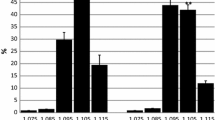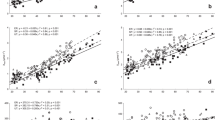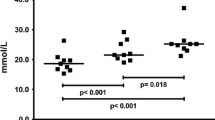Abstract
This study was designed to examine the influence of sub-maximal exercise on purine and pyrimidine catabolism in horses. Ten horses were initially trained for 12 weeks at the end of which they underwent a standardized exercise test (SET); venous blood samples were taken at rest, 5 and 30 min after the SET. Six untrained healthy horses, from which a blood withdrawal was taken at rest, were used as the control group. Samples were analyzed by HPLC for the simultaneous determination of uric acid, uridine, β-pseudouridine and creatinine in plasma. Glucose and lactate were measured in blood. Trained horses had basal uridine levels significantly lower than sedentary horses. The SET caused significant increase in plasma uric acid, uridine, β-pseudouridine and creatinine. Following the SET, a significant negative correlation was found between plasma uridine and glucose, whilst a significant positive correlation was observed between plasma uric acid and creatinine. These results indicate that increase in energy demand during exercise in the horse causes not only the degradation of purine but also of pyrimidine compounds, the latter possibly exerting a control on glucose uptake as also demonstrated in human beings.



Similar content being viewed by others
References
Addabbo F, Montagnani M, Goligorsky MS (2009) Mitochondria and reactive oxygen species. Hypertension 53:885–892
Agüera EI, Rubio MD, Vivo R, Santisteban R, Muñoz A, Castejón F (1995) Blood parameter and heart rate response to training in Andalusian horses. Rev Esp Fisiol 51:55–64
Amorini AM, Petzold A, Tavazzi B, Eikelenboom J, Keir G, Belli A, Giovannoni G, Di Pietro V, Polman C, D’Urso S, Vagnozzi R, Uitdehaag B, Lazzarino G (2009) Increase of uric acid and purine compounds in biological fluids of multiple sclerosis patients. Clin Biochem 42:1001–1006
Burakowski S, Smoleński RT, Bellwon J, Kubasik A, Ciećwierz D, Rynkiewicz A (2007) Exercise stress test and comparison of ST change with cardiac nucleotide catabolite production in patients with coronary artery disease. Cardiol J 14:573–579
Castejón F, Trigo P, Muñoz A, Riber C (2006) Uric acid responses to endurance racing and relationships with performance, plasma biochemistry and metabolic alterations. Equine Vet J Suppl 36:70–73
Charette M, Gray MW (2000) Pseudouridine in RNA: what, where, how, and why. IUBMB Life 49:341–351
Chorell E, Moritz T, Branth S, Antti H, Svensson MB (2009) Predictive metabolomics evaluation of nutrition-modulated metabolic stress responses in human blood serum during the early recovery phase of strenuous physical exercise. J Proteome Res 8:2966–2977
De Moffarts B, Portier K, Kirschvink N, Coudert J, Fellmann N, van Erck E, Letellier C, Motta C, Pincemail J, Art T, Lekeux P (2007) Effects of exercise and oral antioxidant supplementation enriched in (n-3) fatty acids on blood oxidant markers and erythrocyte membrane fluidity in horses. Vet J 174:113–121
Deussen A, Brand M, Pexa A, Weichsel J (2006) Metabolic coronary flow regulation—current concepts. Basic Res Cardiol 101:453–464
Díaz-Araya G, Nettle D, Castro P, Miranda F, Greig D, Campos X, Chiong M, Nazzal C, Corbalán R, Lavandero S (2002) Oxidative stress after reperfusion with primary coronary angioplasty: lack of effect of glucose-insulin-potassium infusion. Crit Care Med 30:417–421
Dreyer HC, Fujita S, Glynn EL, Drummond MJ, Volpi E, Rasmussen BB (2010) Resistance exercise increases leg muscle protein synthesis and mTOR signalling independent of sex. Acta Physiol (Oxf) 199:71–81
Essén-Gustavsson B, Gottlieb-Vedi M, Lindholm A (1999) Muscle adenine nucleotide degradation during submaximal treadmill exercise to fatigue. Equine Vet J Suppl 30:298–302
George J, Struthers AD (2009) Role of urate, xanthine oxidase and the effects of allopurinol in vascular oxidative stress. Vasc Health Risk Manag 5:265–272
Giardina B, Penco M, Lazzarino G, Romano S, Tavazzi B, Fedele F, Di Pierro D, Dagianti A (1993) Effectiveness of thrombolysis is associated with a time-dependent increase of malondialdehyde in peripheral blood of patients with acute myocardial infarction. Am J Cardiol 71:788–793
Graham-Thiers PM, Kronfeld DS, Kline KA, Sklan DJ, Harris PA (2003) Dietary protein and fat effects on protein status in Arabian horses during interval training and repeated sprints. J Equine Vet Sci 23:554–559
Hamada T, Mizuta E, Yanagihara K, Kaetsu Y, Sugihara S, Sonoyama K, Yamamoto Y, Kato M, Igawa O, Shigemasa C, Inokuchi T, Yamamoto T, Shimada T, Ohtahara A, Ninomiya H, Hisatome I (2007) Plasma levels of uridine correlate with blood pressure and indicators of myogenic purine degradation and insulin resistance in hypertensive patients. Circ J 71:354–356
Harkness RA (1988) Hypoxanthine, xanthine and uridine in body fluids, indicators of ATP depletion. J Chromatogr B 429:255–278
Harris RC, Marlin DJ, Snow DH (1987) Metabolic response to maximal exercise of 800 and 2,000 m in the thoroughbred horse. J Appl Phys 63:12–19
Keppler A, Gretz N, Schmidt R, Kloetzer HM, Groene HJ, Lelongt B, Meyer M, Sadick M, Pill J (2007) Plasma creatinine determination in mice and rats: an enzymatic method compares favorably with a high-performance liquid chromatography assay. Kidney Int 71:74–78
Kypson J, Hait G (1976) Effects of uridine and inosine on glucose metabolism in skeletal muscle and activated lipolysis in adipose tissue. J Pharmacol Exp Ther 199:565–574
Lazzarino G, Raatikainen P, Nuutinen M, Nissinen J, Tavazzi B, Di Pierro D, Giardina B, Peuhkurinen K (1994) Myocardial release of malondialdehyde and purine compounds during coronary bypass surgery. Circulation 90:291–297
Lazzarino G, Amorini AM, Fazzina G, Vagnozzi R, Signoretti S, Donzelli S, Di Stasio E, Giardina B, Tavazzi B (2003) Single-sample preparation for simultaneous cellular redox and energy state determination. Anal Biochem 322:51–59
Liebich HM, Müller-Hagedorn S, Klaus F, Meziane K, Kim KR, Frickenschmidt A, Kammerer B (2005) Chromatographic, capillary electrophoretic and matrix-assisted laser desorption ionization time-of-flight mass spectrometry analysis of urinary modified nucleosides as tumor markers. J Chromatogr A 1071:271–275
Lucke JN, Hall GM (1980) A biochemical study of the Arab Horse Society’s marathon race. Vet Rec 107:523–525
Marshall JM (2007) The roles of adenosine and related substances in exercise hyperaemia. J Physiol 583:835–845
Masaki Y, Itoh K, Sawaki T, Karasawa H, Kawanami T, Fukushima T, Kawabata H, Wano Y, Hirose Y, Suzuki T, Sugai S, Umehara H (2006) Urinary pseudouridine in patients with lymphoma: comparison with other clinical parameters. Clin Chim Acta 371:148–151
McGivney BA, Eivers SS, MacHugh DE, MacLeod JN, O’Gorman GM, Park SD, Katz LM, Hill EW (2009) Transcriptional adaptations following exercise in thoroughbred horse skeletal muscle highlights molecular mechanisms that lead to muscle hypertrophy. BMC Genomics 10:638
Moens AL, Champion HC, Claeys MJ, Tavazzi B, Kaminski PM, Wolin MS, Borgonjon DJ, Van Nassauw L, Haile A, Zviman M, Bedja D, Wuyts FL, Elsaesser RS, Cos P, Gabrielson KL, Lazzarino G, Paolocci N, Timmermans JP, Vrints CJ, Kass DA (2008) High-dose folic acid pretreatment blunts cardiac dysfunction during ischemia coupled to maintenance of high-energy phosphates and reduces postreperfusion injury. Circulation 117:1810–1819
Moyer JD, Oliver JT, Handschumacher RE (1981) Salvage of circulating pyrimidine nucleosides in the rat. Cancer Res 41:3010–3017
Piccione G, Giannetto C, Fazio F, Casella S, Caola GA (2009) Comparison of daily rhythm of creatinine and creatine kinase in the sedentary and athlete horse. J Equine Vet Sci 29:575–580
Piccione G, Casella S, Giannetto C, Messina V, Monteverde V, Caola G, Guttadauro S (2010) Haematological and haematochemical responses to training and competition in standardbred horses. Comp Clin Pathol l19:95–101
Pinho RA, Silva LA, Pinho CA, Scheffer DL, Souza CT, Benetti M, Carvalho T, Dal-Pizzol F (2010) Oxidative stress and inflammatory parameters after an ironman race. Clin J Sport Med 20:306–311
Pösö AR, Soveri T, Alaviuhkola M, Lindqvist L, Alakuijala L, Mäenpää PH, Oksanen HE (1987) Metabolic responses to exercise in the racehorse: changes in plasma alanine concentration. J Appl Physiol 63:2195–2200
Räsänen LA, Lampinen KJ, Pösö AR (1995) Responses of blood and plasma lactate and plasma purine concentrations to maximal exercise and their relation to performance in standardbred trotters. Am Vet Res 56:1651–1656
Räsänen LA, Wiitanen PA, Lilius EM, Hyyppä S, Pösö AR (1996) Accumulation of uric acid in plasma after repeated bouts of exercise in the horse. Comp Biochem Physiol B 114:139–144
Refsum HE, Gjessing LR, Strømme SB (1979) Changes in plasma amino acid distribution and urine amino acids excretion during prolonged heavy exercise. Scand J Clin Lab Invest 39:407–413
Rosenmeier JB, Yegutkin GG, González-Alonso J (2008) Activation of ATP/UTP-selective receptors increases blood flow and blunts sympathetic vasoconstriction in human skeletal muscle. J Physiol 586:4993–5002
Sander G, Hülsemann J, Topp H, Heller-Schöch G, Schöch G (1986) Protein and RNA turnover in preterm infants and adults: a comparison based on urinary excretion of 3-methylhistidine and of modified one-way RNA catabolites. Ann Nutr Metab 30:137–142
Schöch G, Topp H, Held A, Heller-Schöch G, Ballauff A, Manz F, Sander G (1990) Interrelation between whole-body turnover rates of RNA and protein. Eur J Clin Nutr 44:647–658
Schuback K, Essén-Gustavsson B (1998) Muscle anaerobic response to a maximal treadmill exercise test in Standardbred trotters. Equine Vet J 30:504–510
Schuback K, Essén-Gustavsson B, Persson SG (2000) Effect of creatine supplementation on muscle metabolic response to a maximal treadmill exercise test in Standardbred horses. Equine Vet J 32:533–540
Schuback K, Essén-Gustavsson B, Persson SG (2002) Effect of sodium bicarbonate administration on metabolic responses to maximal exercise. Equine Vet J Suppl 34:539–544
Snow DH, Harris RC, Gash SP (1985) Metabolic response of equine muscle to intermittent maximal exercise. J Appl Phys 58:1689–1697
Squadrito GL, Cueto R, Splenser AE, Valavanidis A, Zhang H, Uppu RM, Pryor WA (2000) Reaction of uric acid with peroxynitrite and implications for the mechanism of neuroprotection by uric acid. Arch Biochem Biophys 376:333–337
Tavazzi B, Lazzarino G, Leone P, Amorini AM, Bellia F, Janson CG, Di Pietro V, Ceccarelli L, Donzelli S, Francis JS, Giardina B (2005) Simultaneous high performance liquid chromatographic separation of purines, pyrimidines, N-acetylated amino acids, and dicarboxylic acids for the chemical diagnosis of inborn errors of metabolism. Clin Biochem 38:997–1008
Valberg S, Gustavsson BE, Lindholm A, Persson SG (1989) Blood chemistry and skeletal muscle metabolic responses during and after different speeds and durations of trotting. Equine Vet J 21:91–95
Weissman S, Eisen AZ, Lewis M, Karon M (1962) Pseudouridine metabolism. III. Studies with isotopically labeled pseudouridine. J Lab Clin Med 60:40–47
White A, Estrada M, Walker K, Wisnia P, Filgueira G, Valdés F, Araneda O, Behn C, Martínez R (2001) Role of exercise and ascorbate on plasma antioxidant capacity in thoroughbred race horses. Comp Biochem Physiol A 128:99–104
Williamson LH, Andrews FM, Maykuth PL, White SL, Green EM (1996) Biochemical changes in three-day-event horses at the beginning, middle and end of Phase C and after Phase D. Equine Vet J Suppl 22:92–98
Wyss M, Kaddurah-Daouk R (2000) Creatine and creatinine metabolism. Physiol Rev 80:1107–1213
Yamamoto T, Moriwaki Y, Takahashi S, Tsutsumi Z, Yamakita J, Higashino K (1997) Effect of muscular exercise on the concentration of uridine and purine bases in plasma—adenosine triphosphate consumption-induced pyrimidine degradation. Metabolism 46:1339–1342
Zinellu A, Caria MA, Tavera C, Sotgia S, Chessa R, Deiana L, Carru C (2005) Plasma creatinine and creatine quantification by capillary electrophoresis diode array detector. Anal Biochem 342:186–193
Acknowledgments
This work was supported in part by research funds from University of Messina (Alberghina) and University of Catania (Lazzarino). No other disclosures, nor any conflict of interest, were reported.
Conflict of interest
None of the authors has any financial or personal relationships that could inappropriately influence or bias the content of the paper.
Author information
Authors and Affiliations
Corresponding author
Additional information
Communicated by Jacques Poortmans.
Rights and permissions
About this article
Cite this article
Alberghina, D., Piccione, G., Amorini, A.M. et al. Modulation of circulating purines and pyrimidines by physical exercise in the horse. Eur J Appl Physiol 111, 549–556 (2011). https://doi.org/10.1007/s00421-010-1673-6
Accepted:
Published:
Issue Date:
DOI: https://doi.org/10.1007/s00421-010-1673-6




